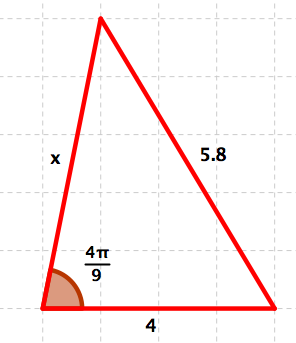Section 4.6 The Law of Sines and the Law of Cosines
Live your life as though your every act were to become a universal law. — Immanuel Kant, German philosopher, 1724 – 1804
Problem: Evaluate x. See Figure 4.61.
Figure 4.61. The unknown length x.Notation: Vertices, Sides, and Angles of a Triangle See Figure 4.62.
Figure 4.62. Vertices, Sides, and AnglesIn a triangle △ABC with vertices A, B, and C:
α is the angle at A.
a is the side opposite A and α.
β is the angle at B.
b is the side opposite B and β.
γ is the angle at C.
c is the side opposite C and γ.
The Law of Sines.
Figure 4.63. Law of sinesWe use Figure 4.63.
Observe that
sinα=hb and sinβ=ha.
Now we calculate the length of h in two different ways:
h=bsinα and h=asinβ.
Hence
bsinα=asinβ.
Similarly, csinα=asinγ.
We write
D=asinα.
Since bsinα=asinβ and csinα=asinγ, it follows that
D=asinα=bsinβ=csinγ.
This is known as the Law of Sines.
Example 4.6.1. Law of sines.
In the triangle △ABC with the usual notation, suppose that sinα=2√23, that a=11 and that b=9. Find sinβ.
Solution
By the Law of Sines
\begin{equation*}
\frac{a}{\sin \alpha} = \frac{b}{\sin \beta} \Rightarrow \frac{11}{\frac{2\sqrt{2}}{3}} = \frac{9}{\sin \beta}\Rightarrow \sin\beta =\frac{9\cdot\frac{2\sqrt{2}}{3}}{11} = \frac{6\sqrt{2}}{11}.
\end{equation*}
Area of a Triangle: The Law of Sines implies that
Area(△ABC)=12acsinβ.
Solution
See Figure 4.64.
Figure 4.64. Area of \(\triangle ABC\text{.}\)In \(\triangle ABC\) with the usual notation, let \(h\) be the hight to the side \(c\text{.}\)
Observe that \(h=a\sin \beta\text{.}\) Thus, the area of the triangle is given by
\begin{equation*}
A=\frac{ch}{2}=\frac{1}{2}\cdot ac\sin\beta .
\end{equation*}
Note: Notice that in this formula, \(\beta\) represents the anglebetween \(a\) and \(c\text{.}\)
Example 4.6.2. Use the given area to find a side.
In △ABC with the usual notation, suppose that sinα=2/3, that b=9 and that the area of △ABC is 24 Find c.
Solution
Note that, in the usual notation, \(\alpha\) represents the angle between \(b\) and \(c\text{,}\) so the area of \(\triangle ABC\) is given by
\begin{equation*}
A=\frac{1}{2}\cdot bc\sin\alpha\Leftrightarrow c=\frac{2A}{b\sin \alpha}.
\end{equation*}
We conclude that in the given triangle
\begin{equation*}
c=\frac{2\cdot 24}{9\cdot \frac{2}{3}}=\frac{2\cdot 24}{6}=8.
\end{equation*}
The Law of Cosines. See Figure 4.65.
See Figure 4.65.
Figure 4.65. Area of △ABC.We use Figure 4.65.
Observe that, by the Pythagorean theorem,
b2=(c−acosβ)2+(asinβ)2=c2−2accosβ+a2cos2β+a2sin2β
=c2−2accosβ+a2(cos2β+sin2β)=c2−2accosβ+a2.
The fact that
b2=a2+c2−2accosβ
is known as the Law of Cosines.
Note: Observe that the the angle β is between the sides a and c and that side b is opposite to the angle β. Hence
c2=a2+b2−2abcosγ and a2=b2+c2−2bccosα
Example 4.6.3. Solve using the Law of Cosines.
Evaluate x. See Figure 4.66.
Figure 4.66. The unknown length x.
Solution
By the Law of Cosines,
\begin{equation*}
5.8^2 =x^2+4^2-2\cdot 4\cdot x\cdot \cos \frac{4\pi}{9}\Leftrightarrow x^2-8x\cos\frac{4\pi}{9}+4^2-5.8^2=x^2-8x\cos\frac{4\pi}{9}-17.64=0.
\end{equation*}
We solve the quadratic equation to obtain
\begin{equation*}
x=\frac{8\cos\frac{4\pi}{9}\pm\sqrt{64\cos\frac{4\pi}{9}+70.26}}{2}\approx\frac{1.39 \pm9.02}{2}
\end{equation*}
and, since \(x\gt 0\) (why?), we reject the negative option.
Thus
\begin{equation*}
x\approx\frac{1.39+9.02}{2}=5.215.
\end{equation*}


